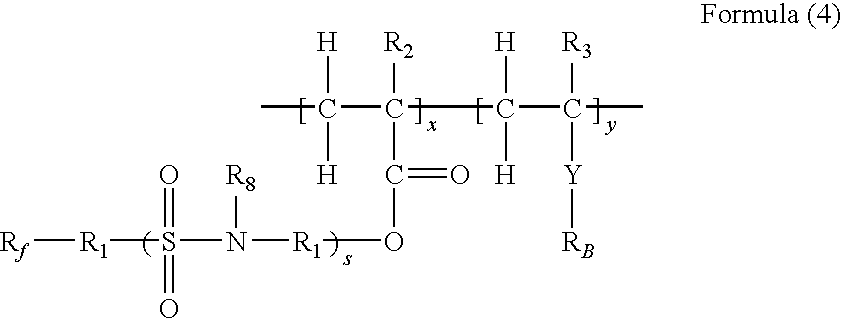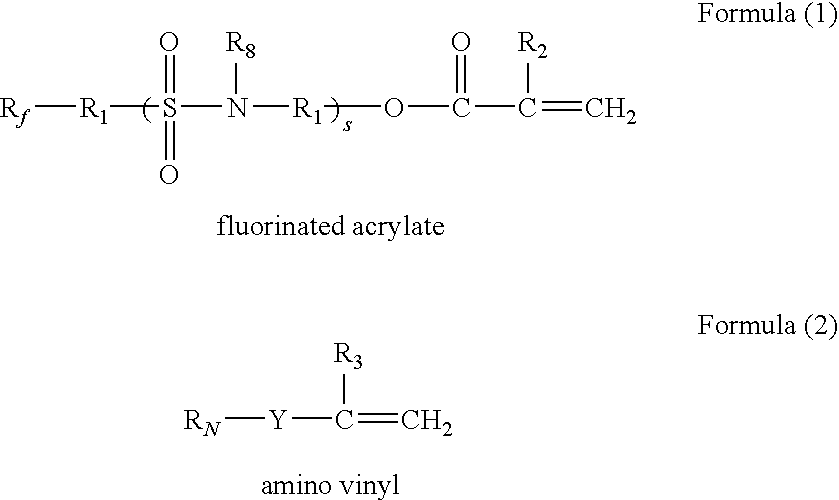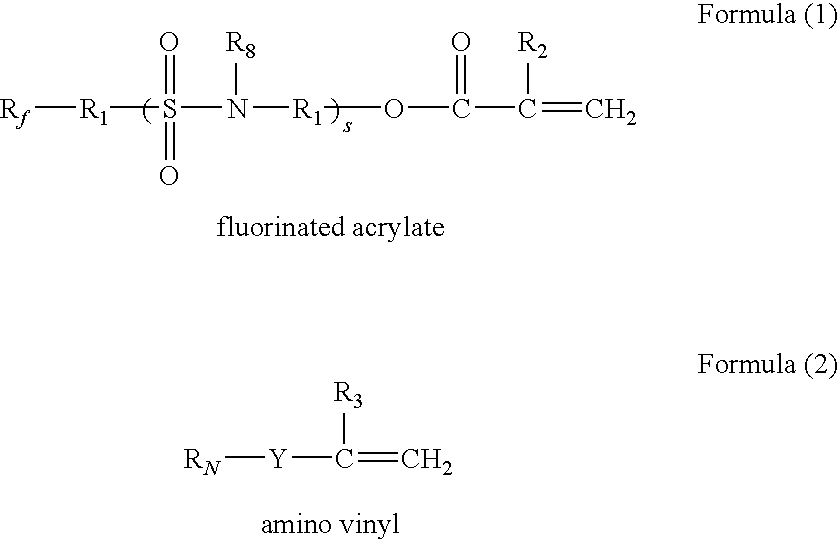Fluorobetaine copolymer and fire fighting foam concentrates therefrom
a fluorosurfactant and foam concentrate technology, applied in fire extinguishers, fibre treatment, textiles and paper, etc., can solve the problem that fluorosurfactants alone cannot sufficiently undergo electrostatic interaction with polyethyleneimine, and achieve the effect of improving the performance of fire fighting foam concentrates
- Summary
- Abstract
- Description
- Claims
- Application Information
AI Technical Summary
Benefits of technology
Problems solved by technology
Method used
Image
Examples
example 1
[0035]A fluorobetaine copolymer of the invention was made according to the following procedure. To a double-jacketed 2.5-L reactor was added dimethylaminoethylmethacrylate (183.8 g, 1.17 mol), fluorinated acrylate monomer (81.8 weight percent purity in acetone, 110.0 g, 0.167 mol), t-butanol (422.9 g, 5.71 mol), and n-dodecyl mercaptan (19.9 g, 97.9 mmol) while stirring (200 rpm). The temperature was raised to 70° C. The reactor was purged with a nitrogen flow for 25 minutes. Azobisisobutyronitrile (1.42 g, 8.64 mmol) was added to the solution. The temperature was maintained for 4 hours under nitrogen. Azobisisobutyronitrile (0.35 g, 2.13 mmol) was added to the solution and the temperature was maintained for 3 hours under nitrogen. A solution of sodium chloroacetate (141.6 g, 1.22 mol) in water (1303.4 g) was added drop by drop over the course of 1 hour and 10 minutes. The temperature was maintained at 70° C. for 1 hour. From this mixture, 500 g of solvent was removed by distillatio...
example 2
[0036]A fire fighting foam concentrate of the invention was made according to the following procedure. 33 g of tap water, 18 g of LUPASOL PS, 2.85 g of AMPHOTENSID B4F, 9.1 g of the product of Example 1 was added at room temperature under vigorous stirring, the pH is adjusted to 7.5 by diglycolic acid, and the solution was adjusted up to 100 g with tap water. A foaming solution was obtained by a dilution of this adjusted solution at 6 percent by weight in tap water to obtain a solution containing 144 ppm of fluorine. The resulting solution, subjected to the tests described above, exhibited the following characteristics: 1 minutes and 27 seconds of extinguishing time; and 6 minutes 10 seconds of re-ignition time.
example 3
[0038]A fire fighting foam concentrate of the invention was made according to the following procedure. 33 g of tap water, 12 g of EPOMIN P-1050, 2.85 of AMPHOTENSID B4F, and 9.1 g of the product of Example 1 was added at room temperature under vigorous stirring, the pH was adjusted to 7.5 by diglycolic acid, and the solution was adjusted up to 100 g with tap water. A foaming solution was obtained by a dilution of this solution at 6 percent by weight in tap water in order to obtain a solution containing 144 ppm of fluorine. The resulting solution, subjected to the tests described above, exhibited the following characteristics: 1 minute and 32 seconds of extinguishing time; and 5 minutes and 48 seconds of re-ignition time.
PUM
| Property | Measurement | Unit |
|---|---|---|
| internal diameter | aaaaa | aaaaa |
| extinguishing time | aaaaa | aaaaa |
| height | aaaaa | aaaaa |
Abstract
Description
Claims
Application Information
 Login to View More
Login to View More - R&D
- Intellectual Property
- Life Sciences
- Materials
- Tech Scout
- Unparalleled Data Quality
- Higher Quality Content
- 60% Fewer Hallucinations
Browse by: Latest US Patents, China's latest patents, Technical Efficacy Thesaurus, Application Domain, Technology Topic, Popular Technical Reports.
© 2025 PatSnap. All rights reserved.Legal|Privacy policy|Modern Slavery Act Transparency Statement|Sitemap|About US| Contact US: help@patsnap.com



